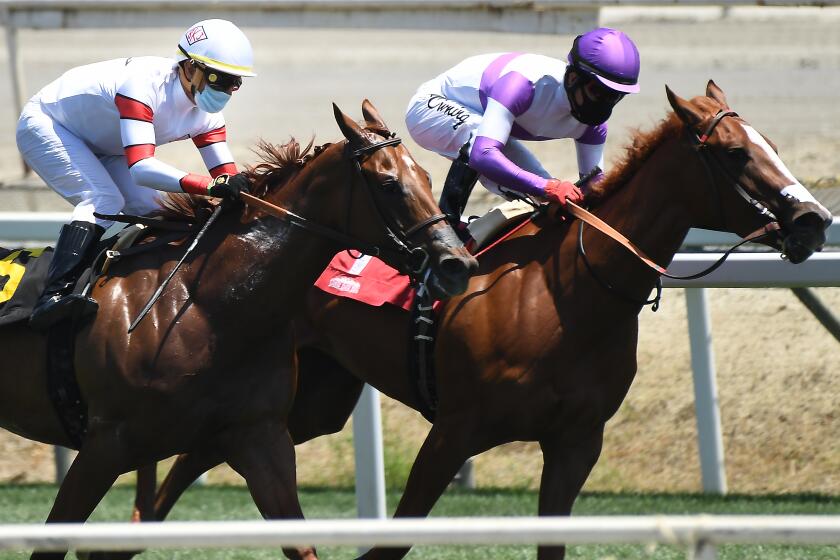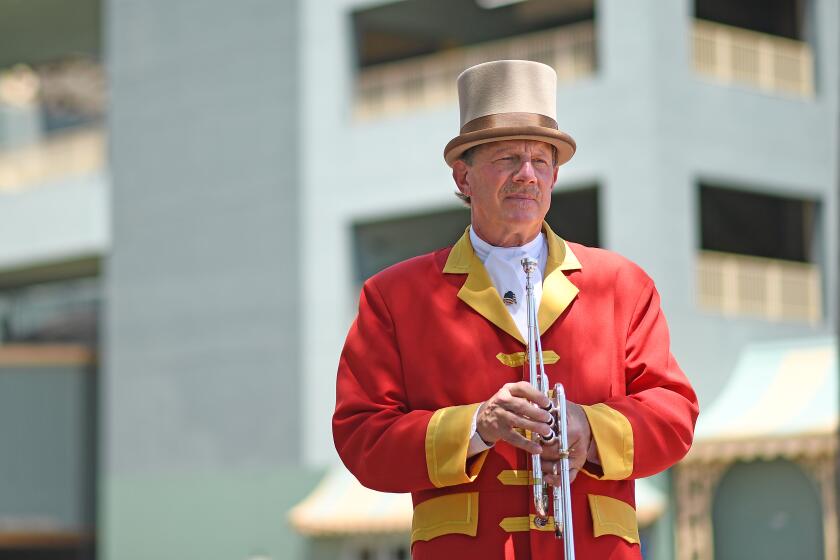Racehorse owners learn why patience is important amid coronavirus restrictions

With owners and spectators banned from Santa Anita, cheering from home is the option
Christian Aurand, a former basketball coach at Simi Valley High, remembers spending every Easter with his father and grandfather having a picnic at Santa Anita Park, hanging out in the infield and watching races.
âItâs been a family thing,â he said. âLater on in life, as my grandfather got older and couldnât go, weâd go to the Ventura fairgrounds, make bets and watch on TV.â
Last year, Aurand decided to make an even bigger commitment to horse racing. He and some friends became owners, joining Slam Dunk Racing in a partnership with interests in six horses. The idea was to experience the fun of horse racing behind the scenes â visit the stables, meet the jockeys, hang out in the paddock with trainers, see the morning workouts at Clockersâ Corner, cheer wildly from the turf club as your horse charges down the stretch trying to win.
âItâs like Disneyland for me,â Aurand said. âItâs the best. Itâs like coaching. Itâs the ultimate fun.â
But many of those perks vanished for Aurand because of the COVID-19 pandemic. The track has been closed to owners since March 20. Then the Los Angeles County Department of Public Health halted racing March 27. It allowed racing to resume May 15 with stringent restrictions, limiting attendance to essential personnel. Temperatures are checked, face coverings are mandatory, and brightly colored wristbands alert security that individuals have passed inspection for that day.
With the resumption of racing at Santa Anita, more than 20 jockeys have to live in trailers on site for the weekends. The setup has created a transformative experience.
âIf horses teach you anything, itâs patience,â said Nick Alexander, chairman of the Thoroughbred Owners of California. âItâs a real good life lesson right now. We have to be patient. The racetrack is doing everything they can. Our job is to keep our horses ready. One of these days weâll get to go back to watch them.â
One of the greatest moments for a thoroughbred-racehorse owner is bringing a carrot, peppermint or horse muffin to the barn and feeling the warm breath of a majestic animal as he lovingly nibbles the treat in the ownerâs hand. But the stable area remains off limits to protect backstretch workers.
Alexander is someone who can offer helpful advice to racingâs newest owners dealing with the sportâs latest challenges. He lives on his farm in Santa Ynez, Calif., breeding and racing horses.
âIf you are going to be a horse owner, the first thing you need to learn is that you lose a lot more than you win and horses take their own time to heal,â he said. âYou have to be patient. Thereâs more bad news than good news in horse racing. Horses break your heart.
âTheyâre the most beautiful animal in the world, and I consider myself the luckiest in the world to live with them, but thereâs some sad days too. A horse gets colic and you canât save them. Your best mare dies in childbirth. Thereâs a lot of sadness with joy, and you have to be willing to take both. We made it through the tough days of Santa Anita last year and thought we were sailing along, and this came along.â
Owners went more than a month paying trainers up to $100 a day for training and boarding without any racing. Then purses at Santa Anita were reduced because of the lost races and the absence of on-track spectators. The question is, will owners be willing to stay in the sport not knowing when a sense of normalcy might return?
Billy Koch, founder and managing partner for the Little Red Feather racing syndicate, said his partners were remaining loyal and patient despite being denied access to activities that helped inspire them to become owners.
âWe miss touching them and smelling [horses] and feeding them carrots,â he said. âBut we understand how hard the people at Santa Anita worked to get racing back. Weâd love to get back there but will abide by what the people at Santa Anita think best. Weâre more than happy to social distance, wear masks and take temperatures. We understand what has to be done right now and are patiently waiting.â
On Saturday, Aurand had horses running in the first and eighth races at Santa Anita. He set up his own âturf side dining clubâ in his backyard, with chairs and a big-screen television on the wall to watch the races.
âThereâs nothing like seeing your horse coming down the stretch and winning,â he said. âThank God we can watch on TV.â
These days, amid the coronavirus closure, Santa Anita Park racetrack bugler Jay Cohen belts out his call to the post for an audience of one.
As the horses entered the starting gate for the first race, Aurand told his guests, âOK, team, letâs go.â
Everyone appeared calm in the beginning. Vertical Threat, a 3-year-old making his debut in a 5½-furlong turf race, didnât start well but began making up ground in the 12-horse field, causing Aurand and his guests to get excited.
âLetâs go boy. Letâs go boy,â Aurand shouted while clapping his hands and rising from his couch.
Vertical Threat finished sixth.
Later, in the $200,000 Charlie Whittingham Stakes, Slam Dunk Racingâs Desert Stone rallied in the stretch to finish fourth.
Just the latest in what has become a daily dose of highs and lows for racehorse owners.
More to Read
Go beyond the scoreboard
Get the latest on L.A.'s teams in the daily Sports Report newsletter.
You may occasionally receive promotional content from the Los Angeles Times.













